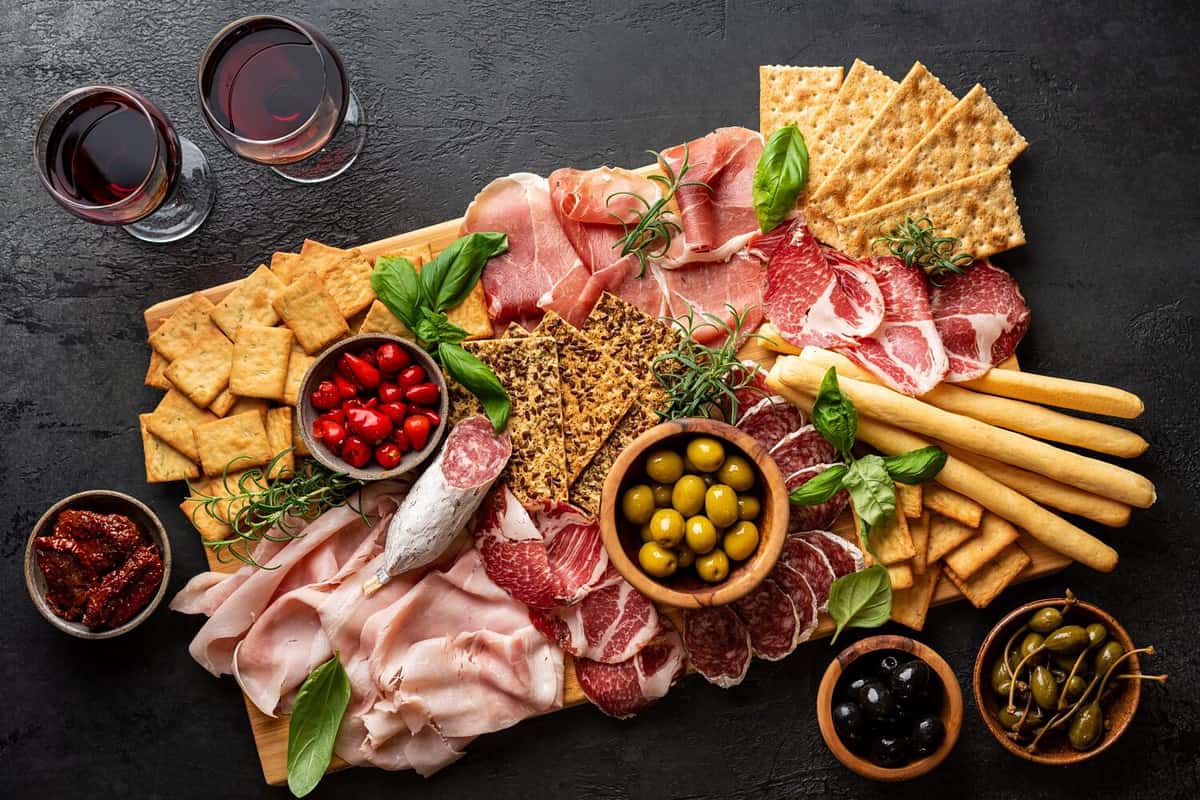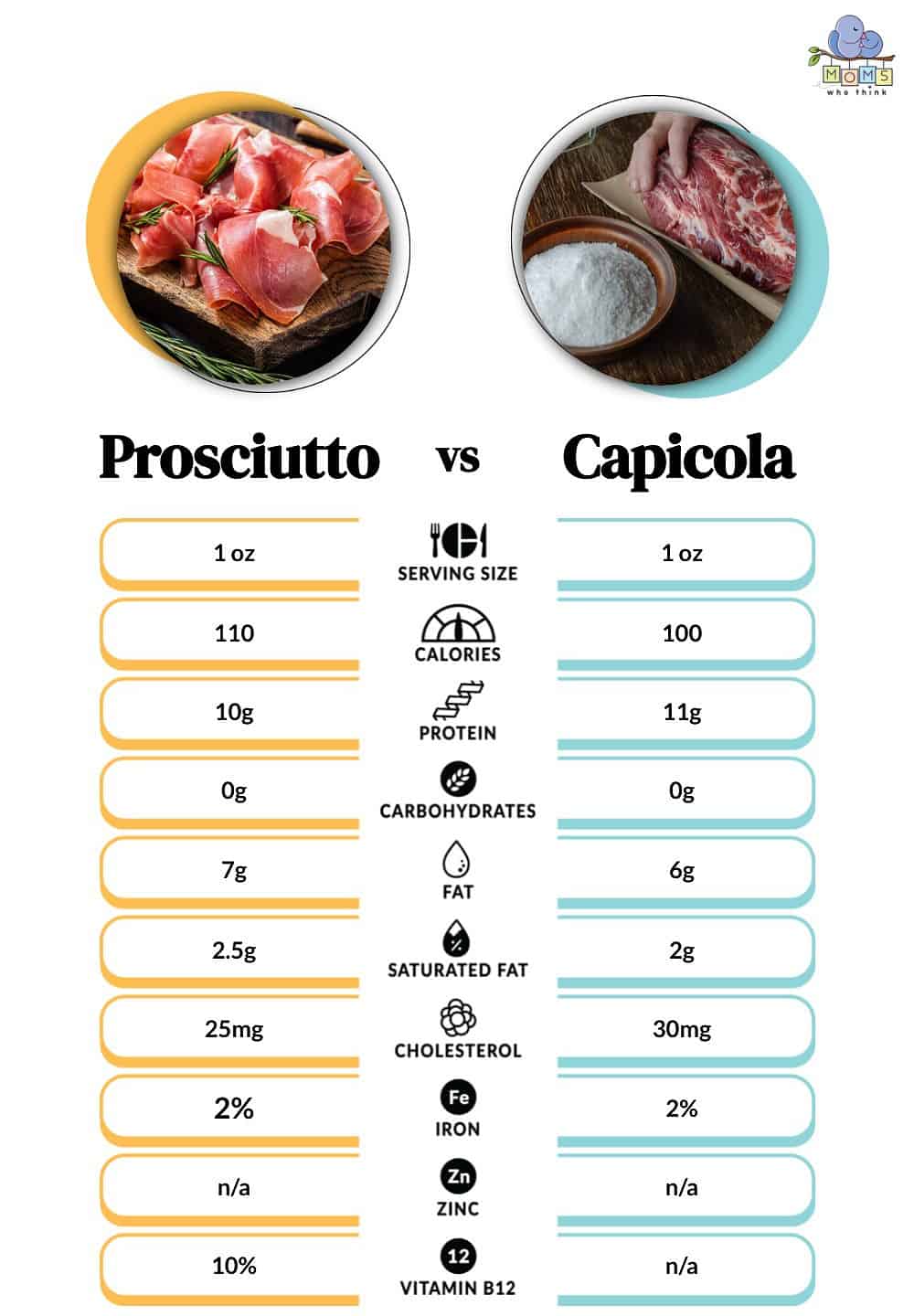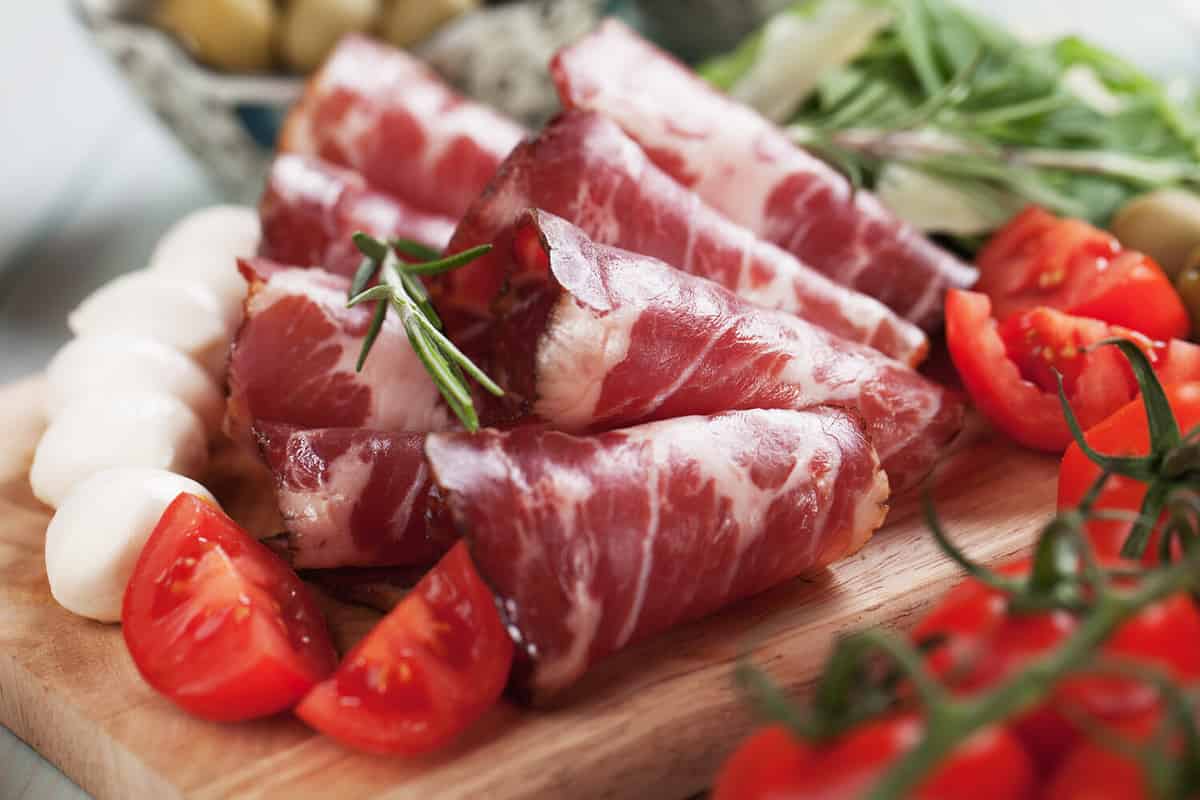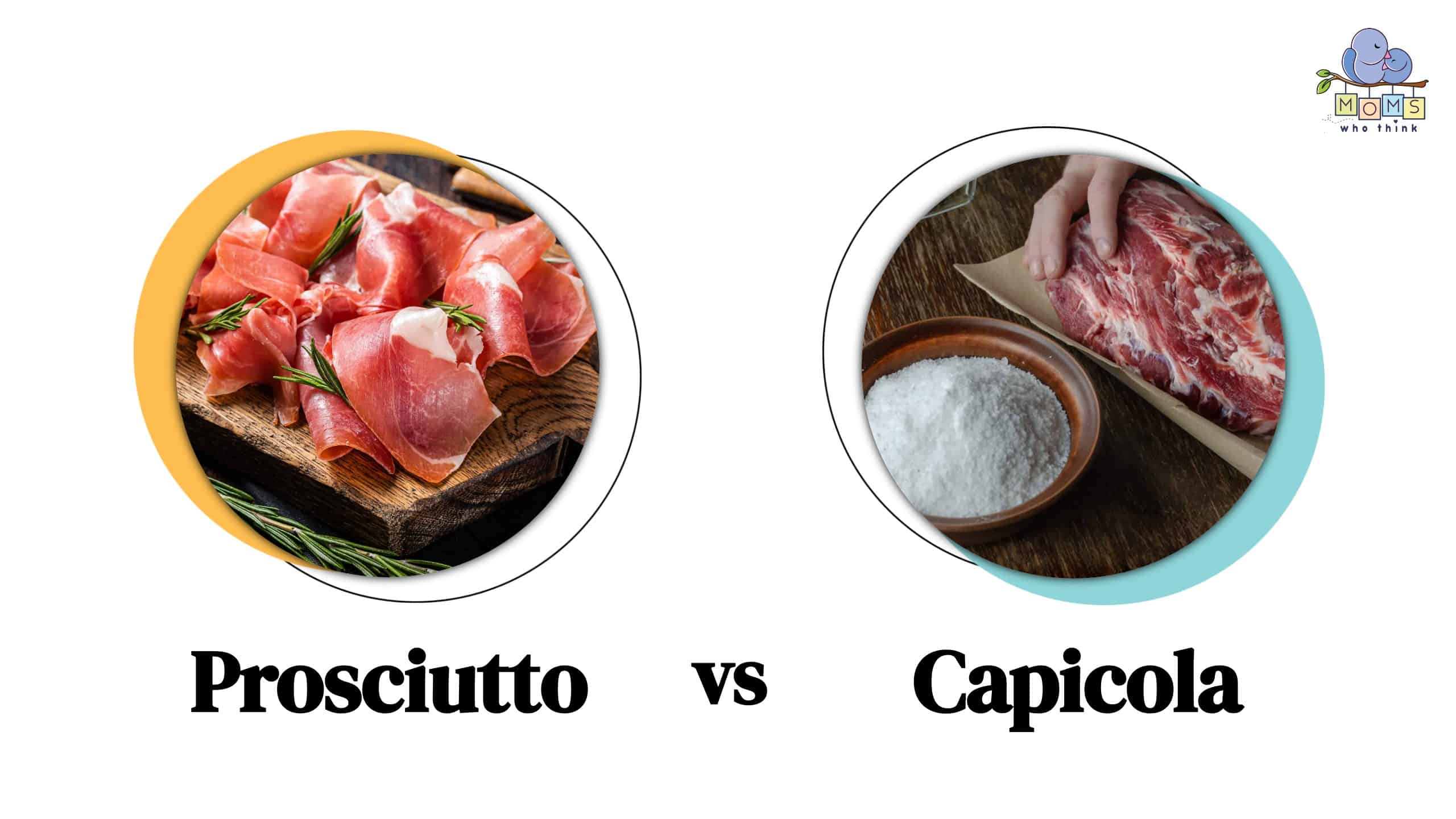Whether you’re putting together an elegant charcuterie board for dinner guests or you’re ordering your favorite sub at the deli, you might wonder about the difference between prosciutto vs capicola. These two popular cured meats are both found in a variety of recipes.
The main difference between prosciutto and capicola is where the meat comes from and their seasonings. Prosciutto and capicola come from different parts of a pig, and while they both fall in the salumi category, prosciutto doesn’t have as many seasonings as capicola.
No matter which cured meat you prefer, they’re both tasty and a perfect addition to any sub or salad. Read on to find out more about which one will be best in your next recipe!

©Goskova Tatiana/Shutterstock.com
Prosciutto vs. Capicola: What Is the Difference?
Cured meats are some of the most delicious additions to salads, subs, or snack plates like a charcuterie board. Even though a lot of the types of cured meats look or even taste similar, there are often distinct differences between them.
Prosciutto and capicola do have some similarities, but they also have a different flavor, texture, and price.
When it comes to the type of meat, prosciutto and capicola fall under the category of salumi. Salumi is a term to describe a wide range of Italian meat products and includes meats such as prosciutto, capicola, pancetta, and salami.
The main differences between prosciutto and capicola are their flavor and texture. These differences come from the fact that prosciutto and capicola come from different cuts of a pig. While prosciutto comes from the hind legs, capicola is cut from a muscle that runs from the neck to one of the ribs. This distinct difference leads to a unique flavor and texture in both meats.
Prosciutto and capicola also taste different because of their seasonings. While prosciutto is seasoned only with sea salt, capicola has a wider variety of seasonings and tends to be spicier. Capicola might include seasonings such as black pepper, chili flakes, and fennel seeds.
Main Differences Between Prosciutto and Capicola
Proscitto and capicola are delicious and can even be found in similar recipes, but there are some distinct differences between them as well. Here are the main differences between prosciutto and capicola:
- Capicola is often spicy
Capicola and proscittuo have unique flavors partly because they include different seasonings. While prosciutto isn’t spicy and is seasoned with salt, capicola has more of a kick to it and includes seasonings such as chili flakes or fennel seeds. - They come from different cuts of a pig
Another reason why these cured meats taste different is because they come from different parts of the pig. While prosciutto is cut from the legs of a pig, capicola comes from a muscle that runs from the pig’s neck to one of its ribs. - Proscittuo has a much more buttery texture
Due to the curing time and the fat content of the meat, proscitto and capicola have a different texture as well. Prosciutto is known for its soft, buttery texture while capicola is still tender but not as silky.
Nutritional Value of Prosciutto vs. Capicola

©
What Is Prosciutto?
In Italian, the word prosciutto is used to describe ham. However, the word originally comes from a phrase that means “dried out.” This name is fitting since the process of making prosciutto involves a slow process of drying out the meat.
Prosciutto in all its forms is made from the legs of a pig and there are two general types of prosciutto known as prosciutto crudo and proscittuo cotto. While prosciutto crudo is uncooked but cured, prosciutto cotto is cooked in a brine.
Prosciutto itself can have a lot of different flavors depending on how it’s made and where it comes from. However, most prosciutto is seasoned with sea salt, which means it doesn’t have as much as a spicy or seasoned flavor as capicola. Aside from the cooked or uncooked versions, there are also different varieties that come from different regions of Italy. For example, there Prosciutto di Parma, a popular type of proscuitto that it cured for twice as long as other varieties.
All types of prosciutto are also known for their thin texture and slightly salty flavor. The process of making prosciutto includes salting the leg of the pig and leaving it to dry for weeks. Then, the salt is washed off and the legs are hung for sixty to ninety days. Finally, the meat is left to dry for around 2 years, or a minimum of one year.

©Igor Dutina/Shutterstock.com
What Is Capicola?
Capicola is another type of cured meat that falls under the salumi category. It has numerous names and is sometimes known as coppa or capocolla, depending on who you’re speaking to. Like prosciutto, it originated in Italy and although there are records of capicola dating back to the 1800s, a version of it has likely been around for thousands of years.
Depending on what region of Italy you visit, there are many varieties of capicola out there. This cured meat is thinly sliced like prosciutto and includes a myriad of spices and unique flavors.
Unlike prosciutto, which is mainly seasoned with sea salt, capicola has a spicy and peppery flavor. Instead of coming from the hind leg of a pig, capicola comes from the muscle between the neck and the fourth or fifth rib of the pig.
The seasonings included can vary by region, but you’ll usually find seasonings like pepper, chili flakes, or fennel seeds. Even though it does have higher fat content than other types of salumi, it doesn’t have quite as much fat as prosciutto. Since there’s less fat on capicola, it doesn’t have as much of a soft and buttery texture, but it does still have a delicious flavor.
Ways to Eat Prosciutto and Capicola
Now that you know the difference between prosciutto and capicola, you might wonder what you can use them for. There are numerous ways to include these cured meats in your meals, whether you add them to a simple weeknight recipe or you’re prepping for an elegant dinner party.
Even though there are differences between capicola and prosciutto, they often serve a similar purpose in the kitchen. You can add prosciutto or capicola to:
- Salads
- Charcuterie boards
- Subs
- Pizza
Finding a way to enjoy these cured meats doesn’t have to be complicated. You can add them to your favorite recipes or you can even enjoy them on a slice of toasted bread with some olive oil. No matter which one you prefer, they can both be a delicious part of any meal.
Can I Substitute Prosciutto for Capicola?
Capicola and prosciutto often serve the same purpose in recipes, but they do bring different flavors to your meal.
If you’re substituting one for the other, keep in mind the differences in their flavors and textures. Capicola doesn’t have as high of a fat content as proscitto. However, since they’re both thin, they can often be used interchangeably.
If you choose capicola instead of prosciutto, you can expect a more spicy flavor. On the other hand, prosciutto offers a milder flavor. You can enjoy them as is or you adjust the other seasonings based on which cured meat you choose. Regardless of how you use them, they both pair well with simple meals, appetizers, and salads.
Capicola vs Prosciutto: Which One to Add to Your Charcuterie Board
Looking for the best way to include capicola or prosciutto to your weekly meal? There are numerous ways to eat these cured meats, whether you add them to a charcuterie board or you use them to spruce up your favorite salad.
If you’re a fan of spicier flavors, you might prefer capicola, but if you’re looking for a classic sweet and salty flavor, prosciutto may be the better choice. If you’re making a charcuterie board, why not add both for your family or guests to enjoy?
Recipe
Print
Chicken Saltimbocca with Prosciutto and Mushroom Sauce
Ingredients
- 1/2 cup all-purpose flour
- 1/4 teaspoon salt
- 1/2 teaspoon pepper, divided
- 8 boneless skinless chicken thighs (2 pounds)
- 2 Tablespoons olive oil, divided
- 2 cups sliced fresh mushrooms
- 2 thin slices prosciutto or deli ham
- 1/2 cup chopped shallots
- 2 garlic cloves, minced
- 1 cup white wine or reduced-sodium chicken broth
- 1 cup reduced-sodium chicken broth
- 1/3 cup half-and-half cream
- 3 Tablespoons fresh sage or 3 teaspoons dried sage leaves, divided
- 1 can (15 ounces) white kidney or cannellini beans, rinsed and drained, divided
- 1/4 cup water
Instructions
- In a large resealable plastic bag, combine the flour, salt, and ¼ teaspoon pepper. Add chicken, a few pieces at a time, and shake to coat.
- In a large skillet over medium heat, cook chicken in 1 Tablespoon oil for 6 to 8 minutes on each side or until juices run clear. Remove and keep warm.
- In the same skillet, sauté the mushrooms, prosciutto, shallots, and garlic in remaining oil until tender.
- Stir in wine. Bring to a boil; cook until liquid is reduced to about ⅓ cup, about 10 minutes.
- Stir in broth. Simmer, uncovered, for 5 minutes or until slightly reduced.
- Stir in cream and 2 Tablespoons sage; heat through (do not boil).
- Meanwhile, in a small saucepan, lightly mash ½ cup beans; add the water. Stir in the remaining pepper, sage and beans. Heat through.
- Add chicken to the mushroom mixture and heat through. Serve with beans.


